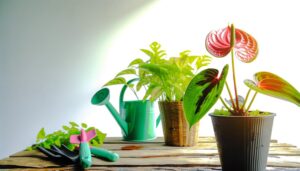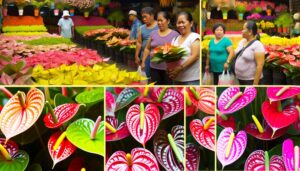Mastering Light Conditions for Anthurium Care: A Guide!
To keep your Anthuriums flourishing, place them in bright, indirect light, mimicking the dappled sunlight of their natural forest habitat. Position them near east or north-facing windows and use sheer curtains to scatter sunlight.
Avoid direct sun exposure, as it can scorch the leaves. For even light distribution, rotate the plant regularly.
During darker months, move them closer to windows or supplement with LED grow lights, maintaining a 12-14 hour light cycle. Monitoring leaf color will help you gauge light sufficiency and make necessary adjustments.
Understanding these details ensures your Anthuriums receive optimal light throughout the year and remain healthy.
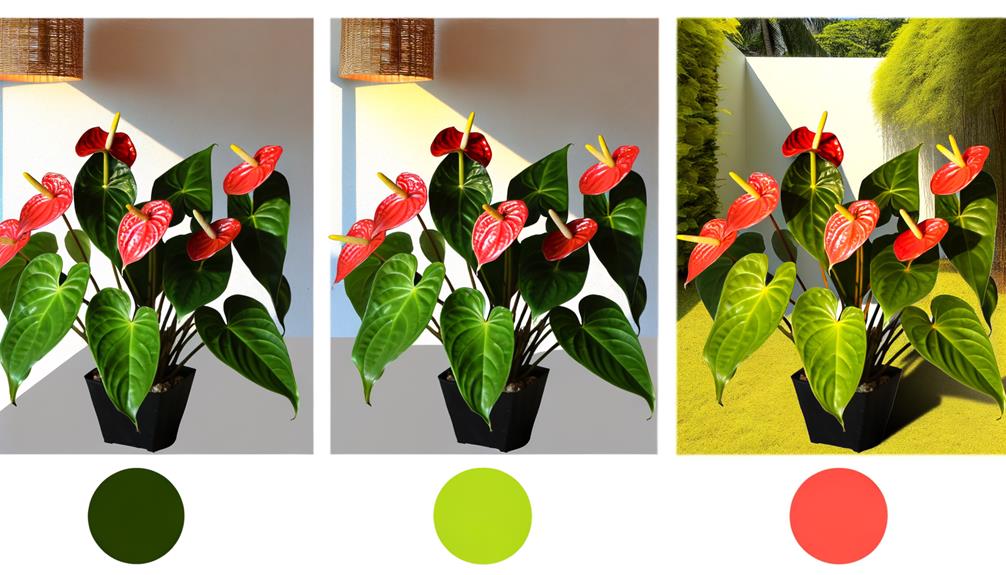
Key Takeaways
- Place anthuriums in bright, indirect light to mimic their natural habitat.
- Utilize sheer curtains to diffuse direct sunlight and prevent leaf burn.
- Rotate the plant regularly to ensure even light distribution on all sides.
- Supplement natural light with LED grow lights, maintaining a 12-14 hour light cycle.
- Adjust light exposure seasonally, moving closer to windows in winter and using curtains in summer.
Understanding Anthurium Light Needs
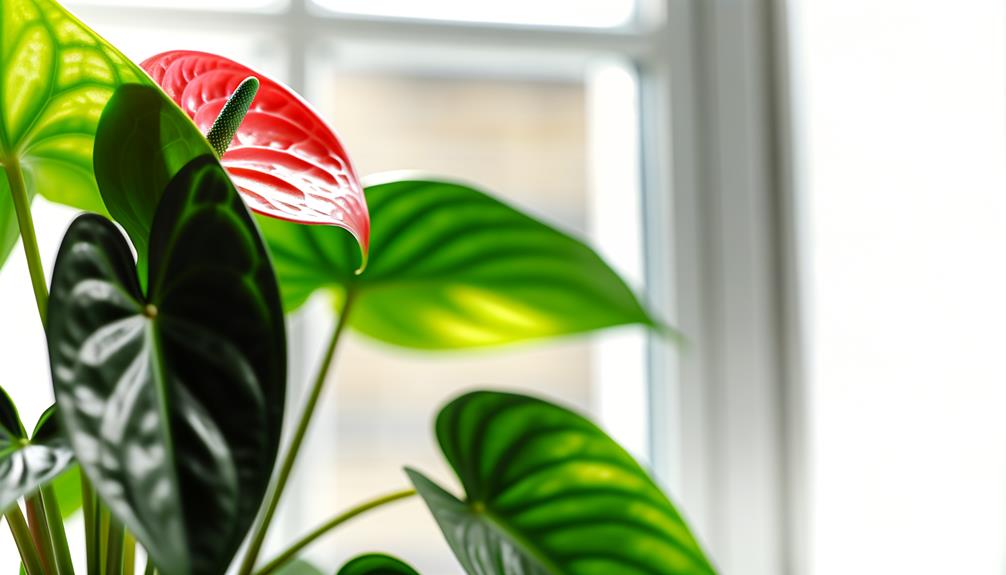
To flourish, Anthuriums need bright, indirect light to imitate their natural rainforest habitat. You should place them in a spot where they receive filtered sunlight, as direct sunlight can scorch their leaves.
Remember, Anthuriums are adapted to dappled light under the forest canopy, so replicating this setting indoors is essential.
Monitor the leaf color to assess their light exposure. Pale or yellowing leaves indicate too much light, while dark green leaves suggest insufficient light. You might need to adjust their position periodically.
Additionally, avoid placing them near heat sources or drafty windows, as temperature fluctuations can stress the plant.
Ideal Indoor Light Levels
When determining the best indoor light levels for Anthuriums, aim for a spot where they receive bright, indirect light for most of the day. Direct sunlight can scorch their leaves, while too little light will stunt their growth.
To achieve ideal conditions, consider placing them near east or north-facing windows. Utilize sheer curtains to diffuse intense light and maintain a consistent environment.
Avoid direct sunlight as it can cause leaf burn.
Ensure consistent brightness to prevent fluctuations that can stress the plant.
Monitor leaf color as yellowing may indicate either too much or too little light.
Managing Natural Sunlight
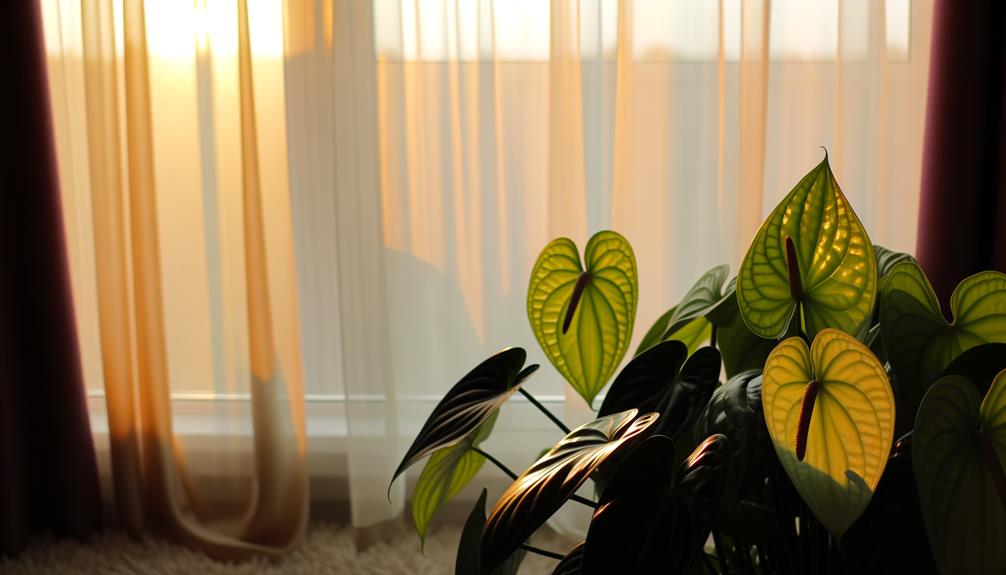
Managing natural sunlight is crucial for guaranteeing your Anthuriums thrive without experiencing leaf burn or stunted growth.
Place your Anthuriums in a location with bright, indirect light. Direct sunlight can scorch the leaves, while too little light can hinder blooming and growth.
Use sheer curtains or position the plant near east or north-facing windows to filter the sunlight. Regularly rotate the plant to secure even light exposure.
| Light Condition | Recommendation | Potential Issue |
|---|---|---|
| Direct Sunlight | Avoid | Leaf Burn |
| Indirect Bright Light | Ideal | None |
| Low Light | Insufficient | Stunted Growth |
| East/North-Facing | Preferred Window Placement | None |
| Filtered Sunlight | Use Sheer Curtains | None |
Using Artificial Lighting
Artificial lighting can effectively supplement natural light for Anthuriums, securing they receive sufficient illumination for optimal growth and blooming.
You should consider using full-spectrum LED grow lights as they imitate natural sunlight, providing the necessary range of wavelengths for photosynthesis.
Position the lights about 12 inches above the plants, maintaining a consistent 12-14 hour light cycle.
Make sure you monitor light intensity and duration to prevent light stress. Key considerations include:
- Light Intensity: Aim for a moderate intensity around 10,000-20,000 lux.
- Duration: Maintain a daily photoperiod of 12-14 hours to simulate tropical conditions.
- Distance: Adjust light distance to prevent leaf burn and secure even light distribution.
These practices will help your Anthuriums thrive indoors, especially in low natural light environments.
Seasonal Light Adjustments
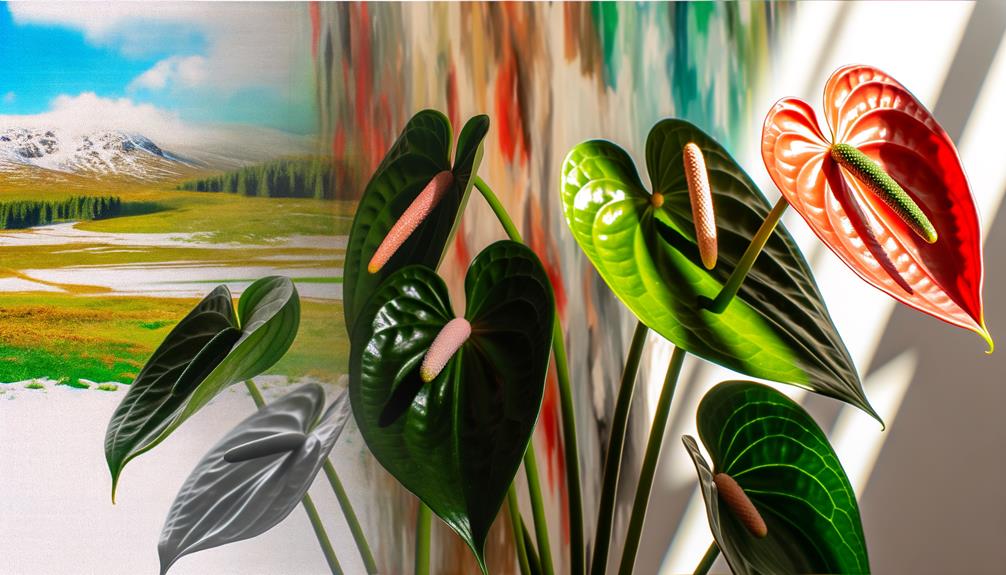
To guarantee your Anthuriums receive the best light year-round, you must adjust their lighting setup to accommodate seasonal changes in natural light availability.
During winter, natural light diminishes, so move your Anthuriums closer to windows that receive maximum sunlight. East or south-facing windows are ideal.
In summer, intense sunlight can scorch leaves. Position your plants in west or north-facing windows, or use sheer curtains to diffuse the light. Regularly rotate the pots to ensure even light distribution.
Monitor your plants closely; yellowing leaves indicate too much light, while leggy growth suggests insufficient light.
By meticulously adjusting their environment, you’ll meet your Anthuriums’ light needs throughout the year, ensuring their health and vibrancy while effectively serving their best care requirements.
Are Anthuriums Hard to Care For
Anthuriums are not particularly hard to care for, but they do have specific needs that must be met to thrive.
They require indirect light, consistent moisture without being waterlogged, and high humidity. With the right environment and attentive care, they can be quite resilient and rewarding houseplants.
Anthurium Care Soil
For Anthurium plants, use a well-draining, loose soil mix with high organic content. A mix of peat moss, pine bark, and perlite is ideal.
Ensure the soil is slightly acidic, with a pH between 5.5 and 6.5, to promote healthy growth. Regularly check for soil moisture and allow the top inch to dry out before watering again.
Conclusion
You’ve now got the knowledge to master light conditions for your Anthurium. By balancing natural sunlight and artificial lighting, and adjusting for seasonal changes, you’re setting the stage for thriving, vibrant plants.
Remember, the right light not only nurtures growth but transforms your Anthurium into a true masterpiece. So, illuminate wisely, and watch your Anthurium flourish like never before.
Don’t just grow it—let it glow!



